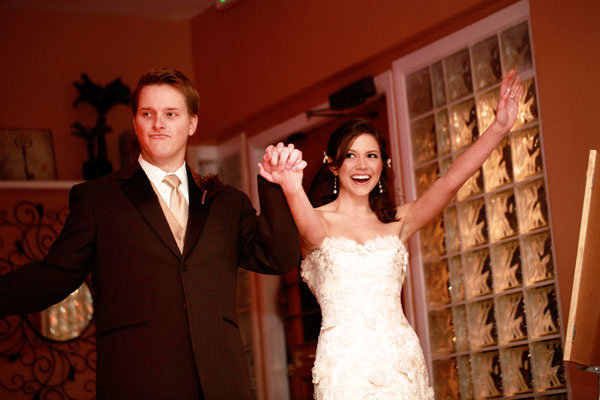Get ready for toasts, speeches, dancing, cake — and don't forget to eat! Use this guide to make sure your reception flows smoothly.
The Receiving Line

Photo Credit: Hoffer Photography
The receiving line is the first element of the wedding reception (unless you already had one after your ceremony). It allows the bride and groom a chance to greet all their guests — an opportunity they might not otherwise have during a large reception.
The line is usually formed with the mother of the bride first, then the father, followed by the groom's mother and father, bride and groom, and then the maid or matron of honor and bridesmaids (the attendants are often left off in order to speed guests" passage through the line). Divorced parents should not stand together in the receiving line. For example, if the bride's parents are divorced and the groom's are not, the groom's parents may stand between the bride's.
To avoid making the receiving line a time-consuming process, exchange brief but warm wishes with everyone as they pass by. It is also courteous for those in the receiving line to introduce the next person: "Mrs. Jones, you look beautiful today! Have you met my husband yet, John Smith?" Help pass the time for guests who are waiting in the line by asking waiters to circulate with drinks and hors d'oeuvres for them. Get more tips for speeding up the receiving line ►
Introductions and Dancing

Photo Credit: D. Park Photography
After the receiving line has been completed and the cocktail hour is finished, it will be time for guests to be seated. After all the guests have found their seats, a master of ceremonies (often the band leader or maitre d') should introduce the bridal party. Instruct the master of ceremonies or whoever will be making the announcements beforehand on how you want the names read (check pronunciations with attendants). Get song ideas for your reception entrance ►
The bride's parents should be the first to enter, followed by the groom's parents, flower girl and ring bearer, bridesmaids and ushers, best man and maid of honor, then the bride and groom.
The first dance often takes place either right after the wedding party has been announced or after the meal is completed. This dance traditionally belongs to the bride and groom, with all guests gathering around to watch. Toward the end of the song, the master of ceremonies or announcer should instruct the rest of the bridal party to join in with their respective partners. The guests may also be asked to join in at the end of the first dance.
At some time during the course of the celebration (but always after the first dance as husband and wife), the bride traditionally has a farewell dance with her father, followed by the groom and her mother. In both cases, a nostalgic, sentimental song is often chosen. If your father will not be there or is deceased, you may choose another important male to share in this special dance with you (a brother, uncle or grandfather). If you are not close to your father and feel more comfortable with your stepfather, you may share the dance with him. The same options apply for your new husband as well. And be sure that both of you dance with your new in-laws and spouse's honor attendants.






